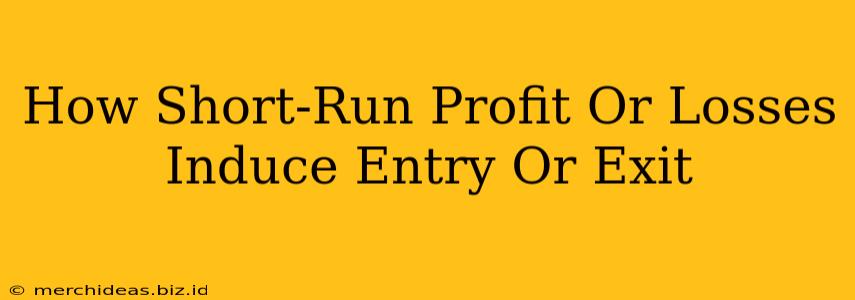In the dynamic world of competitive markets, firms constantly evaluate their short-run performance to determine their long-term viability. Understanding how short-run profits and losses influence entry and exit decisions is crucial for grasping market dynamics and predicting industry evolution. This post will explore this relationship, examining the mechanisms that drive firms to enter or exit a market based on their short-term financial outcomes.
Short-Run Profits: A Magnet for New Entrants
When firms in a market experience short-run economic profits, it signals an attractive opportunity for potential entrants. Economic profit, remember, is the difference between total revenue and total economic cost (including opportunity cost). Positive economic profits indicate that the market is generating returns above what firms could earn in alternative ventures. This excess profitability acts as a powerful incentive for new firms to enter the market, seeking to capture a share of these profits.
The Mechanics of Entry
Several factors facilitate entry into a profitable market:
- Reduced Barriers to Entry: Low start-up costs and readily available technology enable quick entry for new firms.
- Demand Elasticity: High demand elasticity indicates a market responsive to price changes, potentially enabling new entrants to carve a niche.
- Positive Expectations: High profits fuel optimism and expectation of continued success, encouraging investment and entry.
Short-Run Losses: The Push Towards Exit
Conversely, short-run economic losses signal a market that is not generating sufficient returns to cover the economic costs of production. This unsustainable situation forces firms to evaluate their position and consider exiting the market.
The Impetus for Exit
Firms facing losses are driven to exit by several factors:
- Unsustainable Operations: Continued losses erode capital and threaten the firm's long-term survival.
- Resource Reallocation: Losses indicate a misallocation of resources. Exiting allows firms to redirect resources to more profitable ventures.
- Reduced Capacity: Market contraction often results in excess capacity, forcing some firms to exit to avoid further losses.
The Role of Perfect Competition
The concept of perfect competition provides a clear framework for understanding entry and exit. In a perfectly competitive market, firms are price takers, meaning they have no control over the market price. Short-run profits attract new entrants, increasing market supply and ultimately driving down prices until profits are eliminated (reaching zero economic profit in the long run). Similarly, short-run losses induce firms to exit, reducing market supply and raising prices until losses are eliminated. This dynamic process ensures market efficiency.
Beyond Perfect Competition: Imperfect Markets and Barriers to Entry
The reality is most markets are imperfect. Barriers to entry, such as high start-up costs, patents, or government regulations, can impede or slow the entry of new firms even in the face of significant profits. Conversely, even with losses, firms may be locked into a market due to high exit barriers, such as sunk costs or contractual obligations.
In summary: The interplay between short-run profits and losses and the ease or difficulty of entry and exit significantly shapes market structure and competition. While the perfect competition model illustrates a clear mechanism, understanding the nuances of imperfect markets and the presence of barriers to entry provides a more complete picture of market dynamics. Analyzing the specific characteristics of each market is crucial to fully understanding the forces that drive entry and exit decisions.
